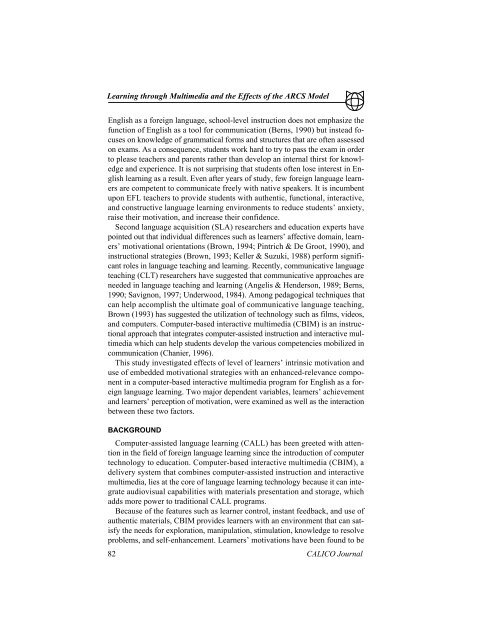Learning Foreign Language through an Interactive Multimedia ...
Learning Foreign Language through an Interactive Multimedia ...
Learning Foreign Language through an Interactive Multimedia ...
Create successful ePaper yourself
Turn your PDF publications into a flip-book with our unique Google optimized e-Paper software.
<strong>Learning</strong> <strong>through</strong> <strong>Multimedia</strong> <strong>an</strong>d the Effects of the ARCS Model<br />
English as a foreign l<strong>an</strong>guage, school-level instruction does not emphasize the<br />
function of English as a tool for communication (Berns, 1990) but instead focuses<br />
on knowledge of grammatical forms <strong>an</strong>d structures that are often assessed<br />
on exams. As a consequence, students work hard to try to pass the exam in order<br />
to please teachers <strong>an</strong>d parents rather th<strong>an</strong> develop <strong>an</strong> internal thirst for knowledge<br />
<strong>an</strong>d experience. It is not surprising that students often lose interest in English<br />
learning as a result. Even after years of study, few foreign l<strong>an</strong>guage learners<br />
are competent to communicate freely with native speakers. It is incumbent<br />
upon EFL teachers to provide students with authentic, functional, interactive,<br />
<strong>an</strong>d constructive l<strong>an</strong>guage learning environments to reduce students’ <strong>an</strong>xiety,<br />
raise their motivation, <strong>an</strong>d increase their confidence.<br />
Second l<strong>an</strong>guage acquisition (SLA) researchers <strong>an</strong>d education experts have<br />
pointed out that individual differences such as learners’ affective domain, learners’<br />
motivational orientations (Brown, 1994; Pintrich & De Groot, 1990), <strong>an</strong>d<br />
instructional strategies (Brown, 1993; Keller & Suzuki, 1988) perform signific<strong>an</strong>t<br />
roles in l<strong>an</strong>guage teaching <strong>an</strong>d learning. Recently, communicative l<strong>an</strong>guage<br />
teaching (CLT) researchers have suggested that communicative approaches are<br />
needed in l<strong>an</strong>guage teaching <strong>an</strong>d learning (Angelis & Henderson, 1989; Berns,<br />
1990; Savignon, 1997; Underwood, 1984). Among pedagogical techniques that<br />
c<strong>an</strong> help accomplish the ultimate goal of communicative l<strong>an</strong>guage teaching,<br />
Brown (1993) has suggested the utilization of technology such as films, videos,<br />
<strong>an</strong>d computers. Computer-based interactive multimedia (CBIM) is <strong>an</strong> instructional<br />
approach that integrates computer-assisted instruction <strong>an</strong>d interactive multimedia<br />
which c<strong>an</strong> help students develop the various competencies mobilized in<br />
communication (Ch<strong>an</strong>ier, 1996).<br />
This study investigated effects of level of learners’ intrinsic motivation <strong>an</strong>d<br />
use of embedded motivational strategies with <strong>an</strong> enh<strong>an</strong>ced-relev<strong>an</strong>ce component<br />
in a computer-based interactive multimedia program for English as a foreign<br />
l<strong>an</strong>guage learning. Two major dependent variables, learners’ achievement<br />
<strong>an</strong>d learners’ perception of motivation, were examined as well as the interaction<br />
between these two factors.<br />
BACKGROUND<br />
Computer-assisted l<strong>an</strong>guage learning (CALL) has been greeted with attention<br />
in the field of foreign l<strong>an</strong>guage learning since the introduction of computer<br />
technology to education. Computer-based interactive multimedia (CBIM), a<br />
delivery system that combines computer-assisted instruction <strong>an</strong>d interactive<br />
multimedia, lies at the core of l<strong>an</strong>guage learning technology because it c<strong>an</strong> integrate<br />
audiovisual capabilities with materials presentation <strong>an</strong>d storage, which<br />
adds more power to traditional CALL programs.<br />
Because of the features such as learner control, inst<strong>an</strong>t feedback, <strong>an</strong>d use of<br />
authentic materials, CBIM provides learners with <strong>an</strong> environment that c<strong>an</strong> satisfy<br />
the needs for exploration, m<strong>an</strong>ipulation, stimulation, knowledge to resolve<br />
problems, <strong>an</strong>d self-enh<strong>an</strong>cement. Learners’ motivations have been found to be<br />
82 CALICO Journal
















